In this article, we explored important facts about people using vibrators, how they work, who uses them, how men feel about them, and their health benefits.
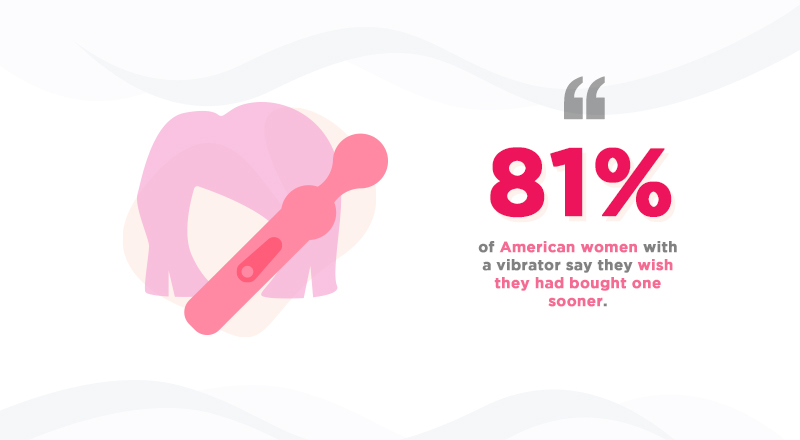
Vibrators have been called a woman’s best friend, but they aren’t only for women. They aren’t only for pleasure either, as research suggests they have significant benefits to sexual health and satisfaction.
Vibrating sex toys have steadily become a cornerstone of sexual gratification. As a result, more and more women are buying vibrators, and many men are overcoming their sexual hangups about them.
Whether you use one for yourself or to satisfy your partner, most people find vibrators to be a positive experience. But how many people actually use them? How do they affect a person’s sexual health?
We combed through studies, surveys, and interviews to answer these questions and more.
Here are some of the most interesting facts we discovered about vibrators:
- 81% of American women with a vibrator say they wish they had bought one sooner.
- Over half (50.9%) of married women use vibrators, but only about a quarter (25.4%) of single women do.
- Nearly a third (32.8%) of men who go to church at least once per week use a vibrator.
- Of men who use vibrators, 31.4% say they do it at their partner’s request; only 6.8% say they do it to have an orgasm of their own.
- A 2009 study found that 47.5% of American women had never used a vibrator.
- Vibrators are the most popular sex toy in the U.S.
- 95% of people who use vibrators say it helps them orgasm.
- 28% of Americans with sex toys never clean them at all.
- Men who used vibrators in the past year rated higher on erectile function, sexual satisfaction, orgasmic function, and sexual desire than men who had never used a vibrator.
How Many Americans Own a Sex Toy?
Sex toys are often portrayed as kinky, hypersexual, and unusual. Yet, despite this, they’re more common than you might think.
Most young Americans own at least one sex toy, and vibrators are the most popular type sold.
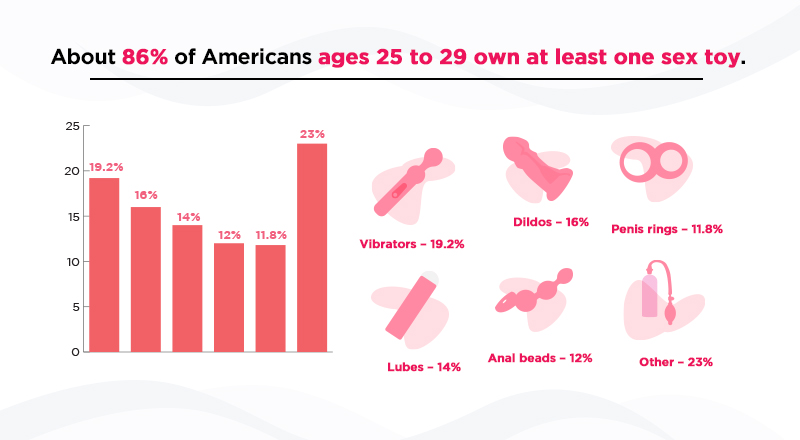
- About 86% of Americans ages 25 to 29 own at least one sex toy. Roughly the same number of Americans ages 40 to 44 do as well. (Statista, 2022a)1
- Americans look for these traits when shopping for sex toys: (Adam & Eve, n.d.)2
- Realistic toys – 25%
- Higher-end toys – 20%
- Smaller toys – 14%
- More powerful toys – 13%
- Larger toys – 4%
- Other types of toys – 25%
- According to Adam & Eve, these are the most popular sex toys bought online: (Adam & Eve, n.d.)2
- Vibrators – 19.2%
- Dildos – 16%
- Lubes – 14%
- Anal beads – 12%
- Penis rings – 11.8%
- Other – 23%
- As of 2022, 163.12 million Americans own sex toys. Of those, 56.46 million own more than 5. (Statista, 2022b)3
- In 2017, only 135.93 million Americans owned sex toys, and 41.83 million had more than 5.
- 47% of people with sex toys own a vibrator, making it the most popular sex toy in the U.S. (Statista, 2022c)4
- 46% own anal toys.
- 40% own lubricants.
- 35% own dildos.
- Vibrators were the most-preferred method of stimulation for women in one survey, with 50.7% preferring non-anal vibrations and 17% preferring anal vibrators. (Le Wand, 2020)5
- 42.5% of participants in one study preferred vibrators for sexual stimulation: (Le Wand, 2020)5
- 23.8% preferred wand vibrators.
- 17.9% preferred bullet vibrators.
- 0.4% preferred clitoral vibrators.
- 0.4% preferred rabbit vibrators.
- Percentage of men who buy vibrators
- Single – 22%
- Attached – 40%
- Percentage of women who buy vibrators
- Single – 65%
- Attached – 16%
How Many Americans Use Vibrators?
Exact numbers are hard to come by, but surveys show that a significant number of Americans are using vibrators for sexual pleasure.
Women use vibrators more than men do, but you might be surprised to learn that married women use them far more than single women. Here’s a look at the numbers.
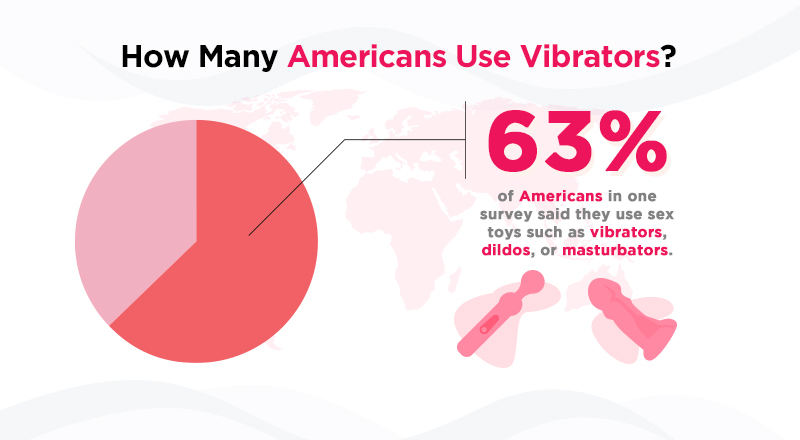
- 80% of American women in one survey said they had tried sex toys. (Statista, 2019a)7
- 63% of Americans in one survey said they use sex toys such as vibrators, dildos, or masturbators. (Adam & Eve, n.d)
- Americans report initiating the use of sex toys in the following ways: (Adam & Eve, n.d)2
- 45% said they don’t use sex toys with a partner.
- 24% said they initiate the use of sex toys.
- 31% said they wait for their partner to mention sex toys.
- A 2009 study found that the prevalence of women’s vibrator use in the U.S. was 52.5% (The Journal of Sexual Medicine, 2009a)8
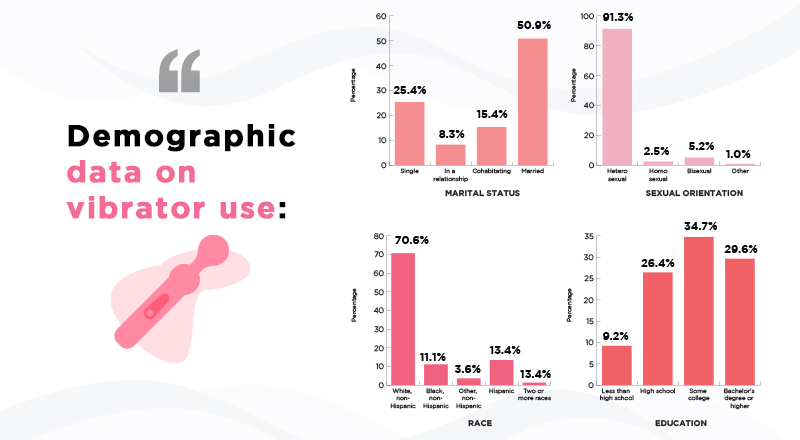
- The same study gave the following demographic data on vibrator use: (The Journal of Sexual Medicine, 2009a)8
- Marital status:
- Single – 25.4%
- In a relationship – 8.3%
- Cohabitating – 15.4%
- Married – 50.9%
- Sexual orientation:
- Heterosexual – 91.3%
- Homosexual – 2.5%
- Bisexual – 5.2%
- Other – 1.0%
- Race:
- White, non-Hispanic – 70.6%
- Black, non-Hispanic – 11.1%
- Other, non-Hispanic – 3.6%
- Hispanic – 13.4%
- Two or more races – 1.3%
- Education:
- Less than high school – 9.2%
- High school – 26.4%
- Some college – 34.7%
- Bachelor’s degree or higher – 29.6%
- Children less than 18 years old at home – 34.6%
- Religious service attendance:
- More than once per week – 7.4%
- 1-4 times per month – 31.5%
- A few times per year – 25.9%
- Once a year or less – 20.1%
- Never – 15.0%
- Marital status:
- In another survey, 44.8% of American men had used a vibrator sexually at some point in their lives. (The Journal of Sexual Medicine, 2009b)9
- This study also provided demographic information on men who use vibrators: (The Journal of Sexual Medicine, 2009b)9
- Age:
- 18 to 24 years old – 14.7%
- 25 to 34 years old – 21.5%
- 35 to 44 years old – 26.4%
- 45 to 54 years old – 23.0%
- 55 to 60 years old – 14.4%
- Marital status:
- Married – 44.0%
- Never married – 29.4%
- Divorced – 13.3%
- Living together (not married) – 9.5%
- Separated – 2.4%
- Widowed – 1.3%
- Ethnicity:
- White, non-Hispanic – 67.5%
- Black, non-Hispanic – 11.0%
- Hispanic – 14.6%
- Other, non-Hispanic – 6.9%
- Education:
- Less than high school – 9.2%
- High school – 26.4%
- Some college – 34.7%
- Bachelor’s degree or higher – 29.6%
- Sexual orientation:
- Heterosexual – 94.9%
- Bisexual – 1.6%
- Homosexual – 2.8%
- Other – 0.8%
- Children under 18 years old in household:
- No – 68.9%
- Yes – 31.1%
- Religious service attendance:
- Never – 16.0%
- Once per year or less – 23.4%
- Few times per year – 19.2%
- Once or twice per month – 8.6%
- Weekly – 22.0%
- More than once per week – 10.8%
- Age:
- 78% of women who have used or currently use sex toys are in a relationship – married women are over twice as likely to use vibrators. (Adam & Eve, n.d.)2
- A survey by SKYN Condoms in 2018 found that female vibrator use increased by 23% from the previous year. (PR Newswire, 2018)10
What Makes a Great Vibrator?
Lots of things make a vibrator great, but the truly exceptional pleasure tools go above and beyond usual standards.
Overall, most women want their vibrators to be safe, easy to use, and powerful.
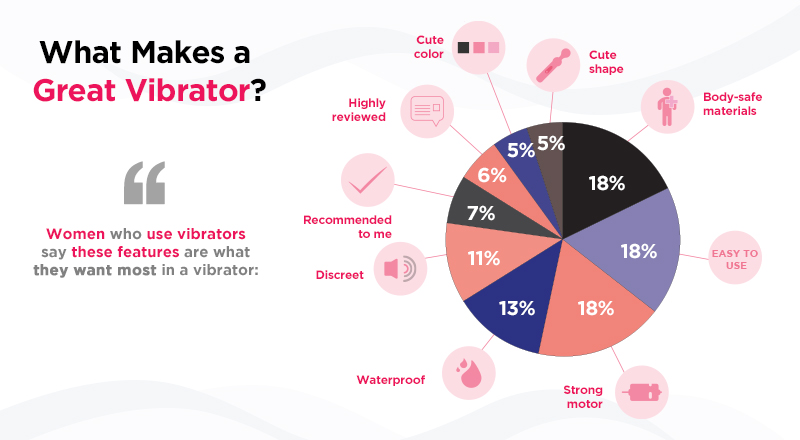
- 7% of American women say they prefer a penis-shaped realistic vibrator. (Statista, 2019b)11
- Women who use vibrators say these features are what they want most in a vibrator: (Minna, 2020)12
- Body-safe materials – 18%
- Easy to use – 18%
- Strong motor – 18%
- Waterproof – 13%
- Discreet – 11%
- Recommended to me – 7%
- Highly reviewed – 6%
- Cute color – 5%
- Cute shape – 5%
- Women who have never used a vibrator say they think they want these features: (Minna, 2020)12
- Body-safe materials – 18%
- Discreet – 15%
- Easy to use – 14%
- Waterproof – 12%
- Recommended to me – 10%
- Highly reviewed – 8%
- Cute shape – 6%
- Cute color – 6%
- Strong motor – 6%
- Not all vibrators are the same, and when it comes to sensation, women prefer the following: (Le Wand, 2020)5
- Rumbly vibrations – 55.1%
- Buzzy vibrations –- 26.2%
- Rumbly & Buzzy vibrations – 18.7%
- For non-anal vibration, women like the following intensities: (Le Wand, 2020)5
- Strong vibration – 50.6%
- Medium vibration – 37.4%
- Light vibration – 10.1%
- Don’t use anal toys – 1.9%
- For anal stimulation, women like the following intensities: (Le Wand, 2020)5
- Strong vibration – 12.9%
- Medium vibration – 18.7%
- Light vibration – 14.8%
- Don’t use anal vibrators – 53.6%
How Often Do People Use Vibrators?
Once you pick up a vibrator, you might find yourself using it several times a week. Surveys and studies analyzed the frequency of vibrator use.
Here’s a look at the results.
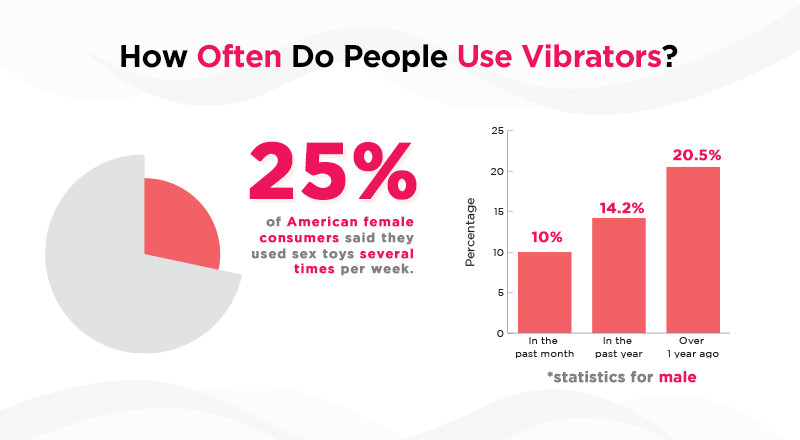
- In 2017, almost 25% of American female consumers said they used sex toys several times per week. 5% said they used sex toys daily. (Statista, 2020a)13
- Men reported the following frequency of their vibrator use: (The Journal of Sexual Medicine, 2009b)9
- In the past month – 10.0%
- In the past year – 14.2%
- Over 1 year ago – 20.5%
Why Do Americans Love to Vibe?
What’s the big deal with vibrators, anyway? Why do people use them?
For some, it’s simple fun. Others find that it helps them or their partner orgasm, while some do it just because they’re curious.
Here’s what research has found on why people use vibrators.
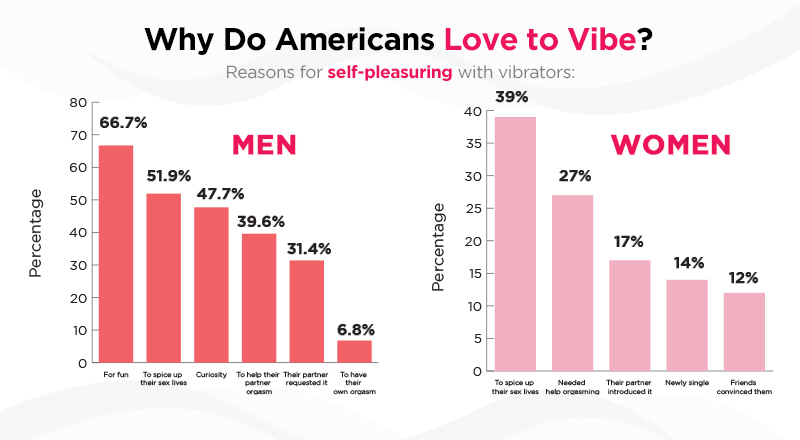
- Men in one study gave the following reasons for self-pleasuring with vibrators. (The Journal of Sexual Medicine, 2009b)9
- For fun – 66.7% of men in the study.
- To spice up their sex lives – 51.9%
- Curiosity – 47.7%
- To help their partner orgasm – 39.6%
- Their partner requested it – 31.4%
- To have their own orgasm – 6.8%
- Women, on the other hand, gave different reasons for using vibrators. (The Journal of Sexual Medicine, 2009a)8
- To spice up their sex lives – 39% of women in the study.
- Needed help orgasming – 27%
- Their partner introduced it – 17%
- Newly single – 14%
- Friends convinced them – 12%
- 59% of women who had experience with sex toys say they simply use them for fun. Nearly half use them to spice up their sex lives, and 20% say sex is better with erotic toys. (Statista, 2020b)14
Who Doesn’t Use Vibrators?
With so many people finding pleasure from vibrators, you might be wondering why anyone chooses NOT to use them.
Close to half of American women have never used a vibrator, but sometimes they just don’t know where to buy one.
This data shows why some people don’t indulge in vibrating sex toys.
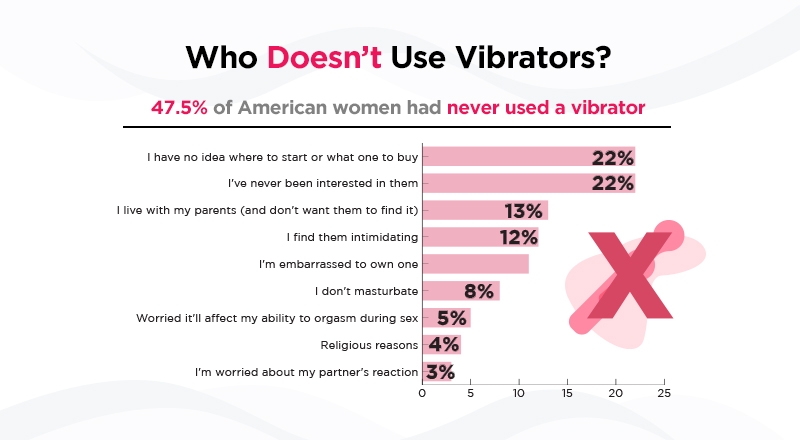
- According to one survey, roughly 6.9% of women in cities never owned a vibrator. (Minna, 2020)12
- In a broader study, 47.5% of American women had never used a vibrator. (The Journal of Sexual Medicine, 2009a)8
- Women who’ve never owned a vibrator gave the following reasons: (Minna, 2020)12
- “I have no idea where to start or what one to buy” – 22%
- “I’ve never been interested in them” – 22%
- “I live with my parents (and don’t want them to find it)” – 13%
- “I find them intimidating” – 12%
- “I’m embarrassed to own one” – 11%
- “I don’t masturbate” – 8%
- “Worried it’ll affect my ability to orgasm during sex” – 5%
- “Religious reasons” – 4%
- “I’m worried about my partner’s reaction” – 3%
- 32% of Americans have seen a roommate, friend, or even a parent’s sex toy out in the open. (Adam & Eve, n.d.)2
When Do People Start Using Vibrators?
No one’s born with a vibrator – they have to be discovered as a part of one’s own sexual journey. For many women, this happens in their 20s.
Most wish they had bought a vibrator sooner. Here’s a look at the numbers.
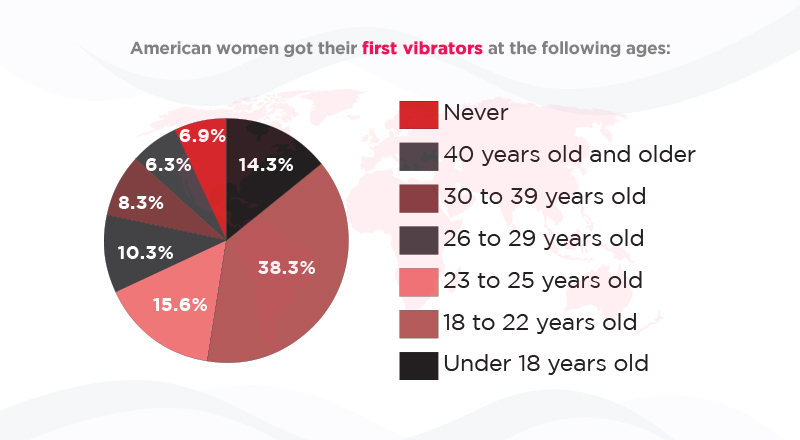
- 50% of respondents in one survey first tried sex toys in their 20s. (Adam & Eve, 2016)15
- 37% of women in the U.S. say they still have their first vibrator. (Minna, 2020)12
- A survey found that American women got their first vibrators at the following ages: (Minna, 2020)12
- Under 18 years old – 14.3%
- 18 to 22 years old – 38.3%
- 23 to 25 years old – 15.6%
- 26 to 29 years old – 10.3%
- 30 to 39 years old – 8.3%
- 40 years old and older – 6.3%
- Never – 6.9%
- By geographic region in the U.S., here’s the data on when women first bought a vibrator: (Minna, 2020)12
- East Coast
- Under 18 – 12%
- Ages 18 to 22 – 36%
- Ages 22 to 25 – 16%
- Ages 26 to 30 – 13%
- Ages 30 to 39 – 9%
- Ages 40+ – 5%
- Never owned a vibrator – 8%
- Midwest
- Under 18 – 13%
- Ages 18 to 22 – 47%
- Ages 22 to 25 – 13%
- Ages 26 to 30 – 7%
- Ages 30 to 39 – 8%
- Ages 40+ – 6%
- Never owned a vibrator – 7%
- Pacific Northwest
- Under 18 – 23%
- Ages 18 to 22 – 39%
- Ages 22 to 25 – 16%
- Ages 26 to 30 – 6%
- Ages 30 to 39 – 11%
- Ages 40+ – 3%
- Never owned a vibrator – 2%
- South
- Under 18 – 17%
- Ages 18 to 22 – 39%
- Ages 22 to 25 – 12%
- Ages 26 to 30 – 14%
- Ages 30 to 39 – 6%
- Ages 40+ – 7%
- Never owned a vibrator – 5%
- Southeast
- Under 18 – 9%
- Ages 18 to 22 – 35%
- Ages 22 to 25 – 20%
- Ages 26 to 30 – 7%
- Ages 30 to 39 – 10%
- Ages 40+ – 7%
- Never owned a vibrator – 12%
- Southwest
- Under 18 – 11%
- Ages 18 to 22 – 38%
- Ages 22 to 25 – 13%
- Ages 26 to 30 – 12%
- Ages 30 to 39 – 10%
- Ages 40+ – 6%
- Never owned a vibrator – 9%
- West Coast
- Under 18 – 13%
- Ages 18 to 22 – 28%
- Ages 22 to 25 – 20%
- Ages 26 to 30 – 14%
- Ages 30 to 39 – 8%
- Ages 40+ – 11%
- Never owned a vibrator – 6%
- Western
- Under 18 – 17%
- Ages 18 to 22 – 40%
- Ages 22 to 25 – 19%
- Ages 26 to 30 – 7%
- Ages 30 to 39 – 4%
- Ages 40+ – 7%
- Never owned a vibrator – 7%
- East Coast
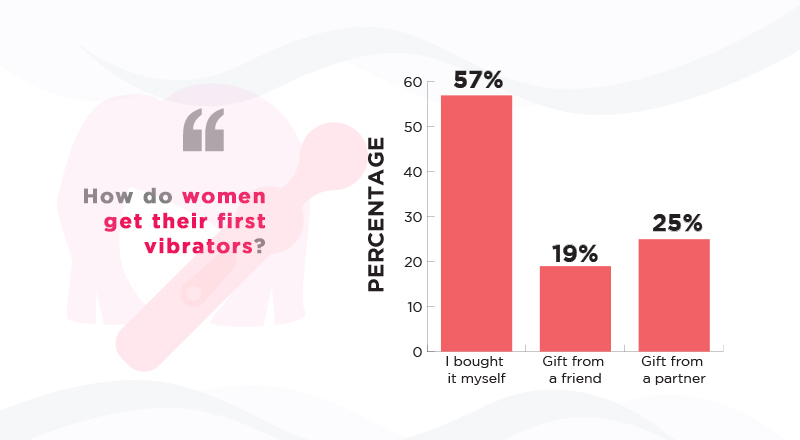
- How do women get their first vibrators? One survey found the following: (Minna, 2020)12
- “I bought it myself” – 57%
- “Gift from a friend” – 19%
- “Gift from a partner” – 25%
- 81% of American women with a vibrator say they wish they had bought one sooner. (Minna, 2020)12
- Why didn’t some women get a vibrator sooner? (Minna, 2020)
- “I had no idea where to start or what one to buy” – 22%
- “I was embarrassed to own one” – 17%
- “I wasn’t interested in them” – 16%
- “Worried it could affect my ability to orgasm during sex” – 10%
- “Worried about my partner’s reaction” – 9%
- “I didn’t masturbate” – 9%
- “I lived with my parents and didn’t want anyone to find it” – 7%
- “Religious reasons” – 4%
Why Do Vibrators Intimidate Some People?
Like with all forms of pleasure, some people find vibrators intimidating. Sex can be a scary thing, and many people are afraid of getting hurt or disappointing their partner.
It’s theorized that vibrators pose a threat to male masculinity, which can make men feel insecure about their own or their partner’s use of sex toys.
However, studies show that the added pleasure of a vibrator can improve male sexual esteem. As it turns out, men feel better about sex when they aren’t the only one who gets to orgasm.
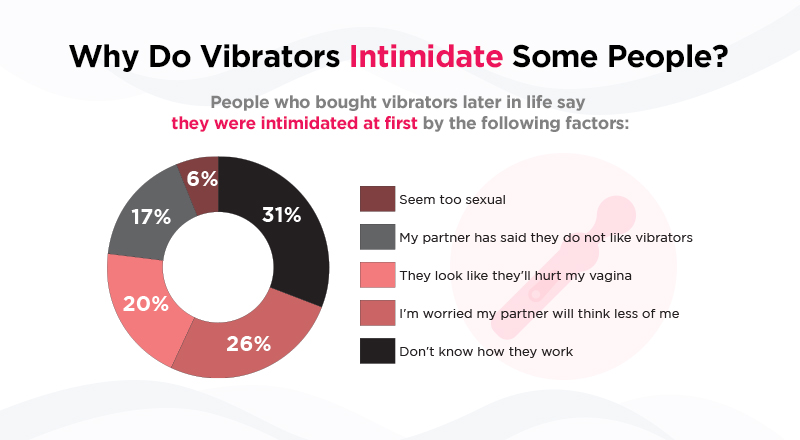
- People who bought vibrators later in life say they were intimidated at first by the following factors: (Minna, 2020)12
- “Don’t know how they work” – 31%
- “I’m worried my partner will think less of me” – 26%
- “They look like they’ll hurt my vagina” – 20%
- “My partner has said they do not like vibrators” – 17%
- “Seem too sexual” – 6%
- One study had men imagine an attractive woman that either did or didn’t orgasm during sex with them, then rate their masculine feeling and sexual esteem. (The Journal of Sex Research, 2017)16
- Men felt more sexual esteem when the woman orgasmed, especially if they had high masculine gender role stress.
- Female orgasms function as a masculine achievement for men; this may cause vibrators to be intimidating.
How Do People Use Vibrators?
There isn’t necessarily a wrong way to use a vibrator, but a few methods are most popular.
Whether you’re alone or with a partner, most people say a vibrator helps them orgasm. Here’s a look at the data.

- One study found that men use vibrators in the followings ways: (The Journal of Sexual Medicine, 2009b)9
- Past month
- Used vibrator masturbating alone – 2.0%
- Used vibrator sexual play with a partner – 7.6%
- Used vibrator sexual intercourse with a partner – 8.6%
- Past year
- Used vibrator masturbating alone – 4.3%
- Used vibrator sexual play with a partner – 12.3%
- Used vibrator sexual intercourse with a partner – 12.6%
- More than a year ago
- Used vibrator masturbating alone – 10.3%
- Used vibrator sexual play with a partner – 16.1%
- Used vibrator sexual intercourse with a partner – 19.3%
- Total number of vibrator users
- Used vibrator masturbating alone – 16.6%
- Used vibrator sexual play with a partner – 40.5%
- Used vibrator sexual intercourse with a partner – 36.0%
- Past month
- Another study found that women use vibrators a little differently: (The Journal of Sexual Medicine, 2009a)8
- Past month
- Used vibrator masturbating alone – 20.1%
- Used vibrator sexual play with a partner – 10.2%
- Used vibrator sexual intercourse with a partner – 9.9%
- Past year
- Used vibrator masturbating alone – 11.4%
- Used vibrator sexual play with a partner – 10.6%
- Used vibrator sexual intercourse with a partner – 9.8%
- More than a year ago
- Used vibrator masturbating alone – 14.8%
- Used vibrator sexual play with a partner – 20.1%
- Used vibrator sexual intercourse with a partner – 17.6%
- Total of vibrator users (ever used in this context)
- Used vibrator masturbating alone – 46.3%
- Used vibrator sexual play with a partner – 40.9%
- Used vibrator sexual intercourse with a partner – 37.3%
- Past month
- 95% of people who use vibrators say it helps them orgasm. (PR Newswire, 2018)10
How Do Men Feel When Women Use Vibrators?

Sure, the way men feel about female vibrator use doesn’t matter, but we looked into it anyway.
Men are typically reluctant to try vibrators at first, but once they dive in, they find that it increases pleasure, communication, and sexual satisfaction in their relationships.
- A survey by condom company SKYN found that 66% of people in relationships incorporate vibrators. (PR Newswire, 2018)10
- Sex toys improve communication and overall sexual satisfaction in relationships. (Adam & Eve, 2016)15
- 60% of Americans who use sex toys said their partner is aware of it and had been for various amounts of time. (Adam & Eve, n.d.)2
- From the beginning of the relationship – 18%
- Dating a month or more – 38%
- Dating a year or more – 44%
- Cosmopolitan interviewed several men on their feelings toward women bringing sex toys to the bedroom. They had mixed opinions: (Cosmopolitan, 2016)17
- “I’m not opposed to the idea, but it’s not something that excites me…“
- “I can imagine some would find it intimidating, but actually, I find it quite sexy that a girl is confident enough to explore and try new things…“
- “Oh kinky, why not?! It could be fun, although they would be more for her pleasure. The toys aren’t to be used on me!“
- “I think it’s a good thing as it allows us to be adventurous. It also spices things up a little…“
- “This has never happened to me before, so it would probably be strange for me at first. I guess it could be fun, though, and if it will heighten the sensation for my partner and give her more pleasure, then why not?!“
- “I haven’t experienced this with a partner before, but if it pleases her, I’m open to the use of sex toys on herself.“
- “I’d be open to the idea of making things more adventurous and fun in the bedroom…“
- “I would have no problem with that at all. You have to experiment in the bedroom to find out what truly turns you on.“
- “I think that sex toys after a few years of marriage should be compulsory in the bedroom… The best thing is that you can use them together or solo when one of us is away.“
- One study found that men’s sexual pleasure was tied to how they perceived their partner’s pleasure, as well as novelty and variety. (Men and Masculinities, 2015)18
- Heterosexual men enjoy vibrators because their partner experiences greater pleasure.
- Another Cosmopolitan article interviewed men on how they feel about women masturbating or using vibrators: (Cosmopolitan, 2020)19
- “Great. It’s sexy as hell, plus everyone’s different. I’m not always going to push the right buttons the right way the first time, but if she shows me while we’re doing things, I can pay attention, learn from her, engage the right areas, use the right kind of touch, or use the right toy the right way to help us both enjoy things.“
- “…I will say for toys, just give me a heads up, especially if this is a hookup/newer relationship/first time using a toy… I enjoy throwing toys in the mix.”
- “Brilliant. It shows how much she trusts me with her feelings at a very intimate time. Or she don’t give a fuck and just wants to get off. Either of those is good for me.“
- “I don’t mind. I find it nice if she’s completely enjoying herself…”
- “I think it is extremely sensual!“
Vibrator Hygiene
We really shouldn’t have to say this, but clean your sex toys.
Seriously, it’s nasty. That being said, here’s what surveys and studies have found about the hygiene habits of vibrator users.
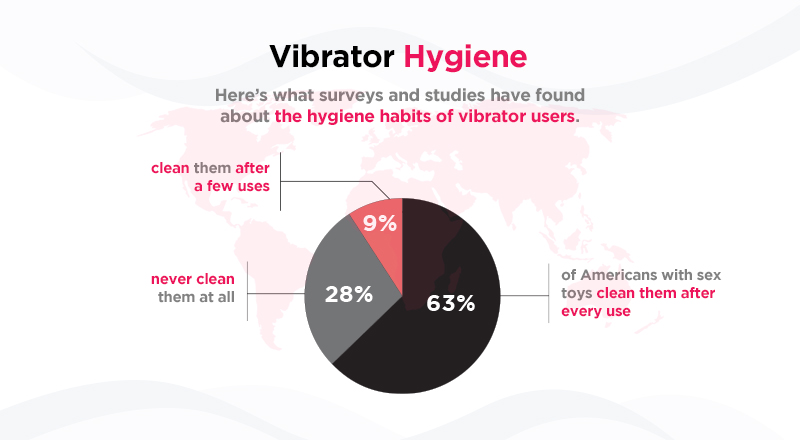
- 63% of Americans with sex toys clean them after every use, 9% clean them after a few uses, and 28% never clean them at all. (Adam & Eve, n.d.)2
- When do men clean their vibrators? Here’s what one study found: (The Journal of Sexual Medicine, 2009b)9
- After using vibrators – 73.2%
- Before using vibrators – 59.9%
- Both before and after using vibrators – 53.4%
- Men who clean their vibrators are far more likely to use soap and water than a commercial cleaner. (The Journal of Sexual Medicine, 2009b)9
- About one-fifth (20.2%) said they never cleaned their vibrator at all.
Vibrators and Sexual Health
Though men often fear that using a vibrator is unmasculine, it has positive effects on sexual function.
Women experience benefits to their health too. Here’s what the research has to say.
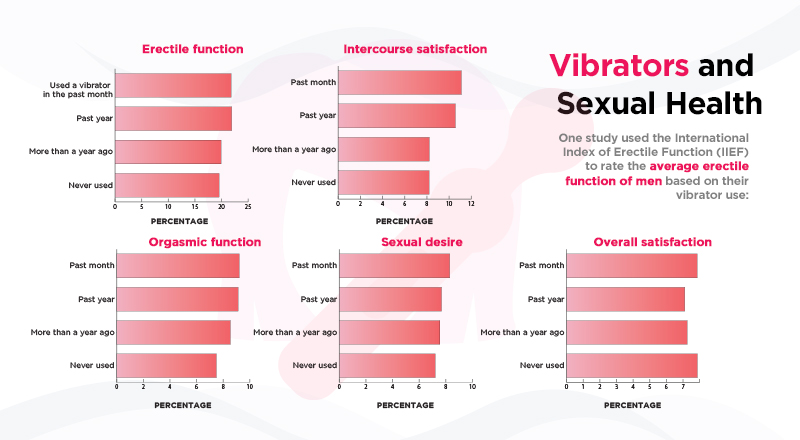
- Vibratory stimulation can treat erectile dysfunction, ejaculatory dysfunction, and anorgasmia (delayed, infrequent, or absent orgasms). (Sexual and Relationship Therapy, 2020)20
- It’s positively correlated with increases in sexual desire and overall function.
- It has shown benefits for pelvic floor dysfunction and difficulties with sexual arousal.
- One study analyzed the quality of life and health of men by their history of vibrator use: (The Journal of Sexual Medicine, 2009b)9
- Total sample
- The proportion of men reporting good to excellent health – 89.7%
- Number of physically unhealthy days in the past month (average) – 3.11 days
- Number of mentally unhealthy days in the past month – 3.38 days
- Number of activity limiting days in the past month – 2.04 days
- Used vibrator in the past month
- The proportion of men reporting good to excellent health – 91.2%
- Number of physically unhealthy days in the past month (average) – 3.15 days
- Number of mentally unhealthy days in the past month – 4.49 days
- Number of activity limiting days in the past month – 2.43 days
- Used vibrator in the past year
- The proportion of men reporting good to excellent health – 91.4%
- Number of physically unhealthy days in the past month (average) – 4.16 days
- Number of mentally unhealthy days in the past month – 4.10 days
- Number of activity limiting days in the past month – 2.37 days
- Used vibrator more than a year ago
- The proportion of men reporting good to excellent health – 90.4%
- Number of physically unhealthy days in the past month (average) – 3.16 days
- Number of mentally unhealthy days in the past month – 3.64 days
- Number of activity limiting days in the past month – 2.19 days
- Never used a vibrator
- The proportion of men reporting good to excellent health – 89%
- Number of physically unhealthy days in the past month (average) – 2.81 days
- Number of mentally unhealthy days in the past month – 2.89 days
- Number of activity limiting days in the past month – 1.64 days
- Total sample
- The same study used the International Index of Erectile Function (IIEF) to rate the average erectile function of men based on their vibrator use and found that men who never used vibrators had worse (lower) IIEF scores. (The Journal of Sexual Medicine, 2009b)9
- Erectile function (range 1-30)
- Used a vibrator in the past month – 21.82
- Past year – 21.92
- More than a year ago – 19.90
- Never used – 19.54
- Intercourse satisfaction (range 0-15)
- Past month – 11.12
- Past year – 10.58
- More than a year ago – 8.23
- Never used – 8.20
- Orgasmic function (range 0-10)
- Past month – 9.22
- Past year – 9.13
- More than a year ago – 8.55
- Never used – 7.50
- Sexual desire (range 2-10)
- Past month – 8.30
- Past year – 7.69
- More than a year ago – 7.56
- Never used – 7.22
- Overall satisfaction (range 2-10)
- Past month – 7.86
- Past year – 7.11
- More than a year ago – 7.26
- Never used – 7.87
- Erectile function (range 1-30)
- 35.4% of men in the study had some level of erectile dysfunction. They rated their ED severity with IIEF scores: (The Journal of Sexual Medicine, 2009b)9
- Severe ED (IIEF-EF score is less than 10) – 6.7%
- Moderate ED (IIEF-EF score 11 to 16) – 20.7%
- Mild/Moderate ED (IIEF-EF score 17 to 21) – 3.6%
- Mild ED (IIEF-EF score 22 to 25) – 7.1%
- Women who use vibrators reported the following health status and behaviors: (The Journal of Sexual Medicine, 2009a)8
- Healthy days measure
- Generally good to excellent health – 90.3%
- Number of physically and/or mentally days in the past month (average) – 7.8 days
- Number of days of limited activity (mean) – 2.3 days
- Percentage of women who experience frequent mental distress – 14.3%
- Health-promoting behaviors
- Women who had a Gynecologic exam in the past year – 72.4%
- Women who had Breast self-exam in the past month – 61.2%
- Women who had Genital self-exam in the past month – 30.7%
- Healthy days measure
- 35.4% of men in the study had some level of erectile dysfunction. They rated their ED severity with IIEF scores: (The Journal of Sexual Medicine, 2009b)9
- Severe ED (IIEF-EF score is less than 10) – 6.7%
- Moderate ED (IIEF-EF score 11 to 16) – 20.7%
- Mild/Moderate ED (IIEF-EF score 17 to 21) – 3.6%
- Mild ED (IIEF-EF score 22 to 25) – 7.1%
- Women who use vibrators reported the following health status and behaviors: (The Journal of Sexual Medicine, 2009a)8
- Healthy days measure
- Generally good to excellent health – 90.3%
- Number of physically and/or mentally days in the past month (average) – 7.8 days
- Number of days of limited activity (mean) – 2.3 days
- Percentage of women who experience frequent mental distress – 14.3%
- Health-promoting behaviors
- Women who had a Gynecologic exam in the past year – 72.4%
- Women who had Breast self-exam in the past month – 61.2%
- Women who had Genital self-exam in the past month – 30.7%
- Healthy days measure
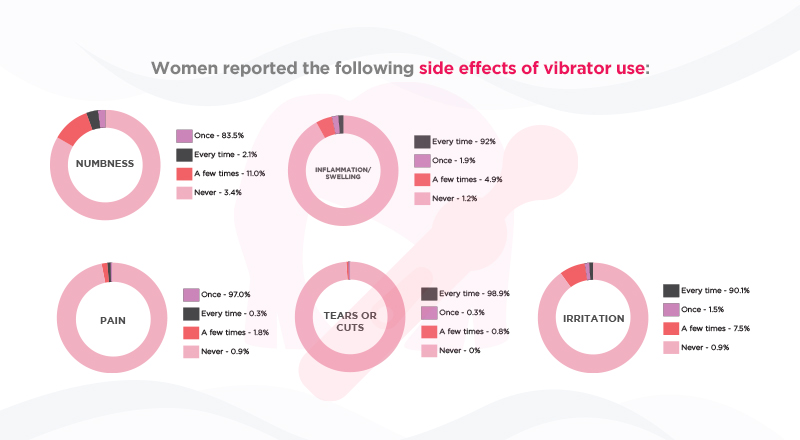
- Women reported the following side effects of vibrator use: (The Journal of Sexual Medicine, 2009a)8
- Numbness
- Frequency of side effects
- Never – 83.5%
- Once – 2.1%
- A few times – 11.0%
- Every time – 3.4%
- Duration of side effects
- Not applicable – 83.5%
- Less than 5 minutes – 9.0%
- Less than an hour – 6.4%
- An hour or more – 0.6%
- More than a day – 0.5%
- Severity rating (range 1-10)
- Mean score – 4.04
- Median score – 4
- Frequency of side effects
- Pain
- Frequency of side effects
- Never – 97.0%
- Once – 0.3%
- A few times – 1.8%
- Every time – 0.9%
- Duration of side effects
- Not applicable – 97.0%
- Less than 5 minutes – 1.0%
- Less than an hour – 0.6%
- An hour or more – 0.8%
- More than a day – 0.6%
- Severity rating (range 1-10)
- Mean score – 3.65
- Median score – 3
- Frequency of side effects
- Irritation
- Frequency of side effects
- Never – 90.1%
- Once – 1.5%
- A few times – 7.5%
- Every time – 0.9%
- Duration of side effects
- Not applicable – 90.1%
- Less than 5 minutes – 1.1%
- Less than an hour – 4.6%
- An hour or more – 1.6%
- More than a day – 2.6%
- Severity rating (range 1-10)
- Mean score – 3.91
- Median score – 4
- Frequency of side effects
- Inflammation/Swelling
- Frequency of side effects
- Never – 92%
- Once – 1.9%
- A few times – 4.9%
- Every time – 1.2%
- Duration of side effects
- Not applicable – 92%
- Less than 5 minutes – 0.9%
- Less than an hour – 3.9%
- An hour or more – 1.7%
- More than a day – 1.5%
- Severity rating (range 1-10)
- Mean score – 3.96
- Median score – 4
- Frequency of side effects
- Tears or cuts
- Frequency of side effects
- Never – 98.9%
- Once – 0.3%
- A few times – 0.8%
- Every time – 0%
- Duration of side effects
- Not applicable – 98.9%
- Less than 5 minutes – 0%
- Less than an hour – 0.1%
- An hour or more – 0.9%
- More than a day – 0.1%
- Severity rating (range 1-10)
- Mean score – 2.36
- Median score – 1
- Frequency of side effects
- Numbness
Conclusion
Vibrators are the world’s foremost sex toy, and about half of women use them to help achieve orgasm. Men mostly use vibrators to help pleasure women, but more of them are starting to find sexual satisfaction from vibrating toys.
Women usually discover vibrators in their 20s, and most wish they’d bought one sooner. The best vibrators are safe, easy to use, and have a powerful motor that won’t quit on pleasure. Most men and women try them out of curiosity, fun, or the need to spice up their sex life.
Some people are afraid that a vibrator may hurt them or affect their ability to orgasm, but side effects are incredibly rare. For most people, vibrators make it easier for them to orgasm and enhance their sexual experience.
For women and men, overall sexual health improves with vibrator use. The effect is greater in men, and research shows that vibrators help treat erectile dysfunction and other sexual issues. Many men worry that using a vibrator is emasculating, but that’s a tough argument to make when it gives them harder erections.
Studies show that men and women are both better sexually satisfied when a vibrator is used, even if they aren’t the ones getting pleasure from it. A vibrating sex toy might feel like a big step, but the overwhelming majority of experiences are positive.
If you’re on the fence about it, talk to your partner and give it a shot. You just might like it.
Footnotes
- Statista, 2022a. A statistic report on the number of people in the United States who own a sex toy using data from a survey of 1,760 American adults.
- Adam & Eve, n.d. An infographic report on the American sex toy industry using data from a survey of over 1,000 American adults.
- Statista, 2022b. A statistic report on the number of people with sex toys in the U.S. using survey data from 1,760 adults in 2017 and 2022.
- Statista, 2022c. A statistic report on the types of sex toys in the U.S. using data from a survey of 1,760 American adults.
- Le Wand, 2020. An article on sex toy preferences using data from a survey of 193 women.
- Jon Millward, 2014. A study on erotic tastes and kinks using data from Lovehoney sex toy sales.
- Statista, 2019a. A statistical report on data from a 2017 survey of 974 American adult women on whether or not they had tried sex toys.
- The Journal of Sexual Medicine, 2009a. A study on vibrator use in 3,800 American women aged 18 to 60.
- The Journal of Sexual Medicine, 2009b. A study on vibrator use in 1,047 American men aged 18 to 60.
- PR Newswire, 2018. An article on the results of a SKYN condom survey of 3,938 sexually active millennials in the U.S.
- Statista, 2019b. A statistical report on the preferred vibrator shapes of 974 American adult women in 2017.
- Minna, 2020. An article on female sex toy purchasing habits using data from a survey of 1,003 American women.
- Statista, 2020a. A statistical report on the use frequency of sex toys of 781 American women in 2017.
- Statista, 2020b. A statistical report on a 2017 survey of 781 American women on why they use sex toys.
- Adam & Eve, 2016. An article on the use of sex toys and vibrators in America using data from a survey of over 1,000 adults.
- The Journal of Sex Research, 2017. A study of 810 American men on whether female orgasms constitute a masculinity achievement.
- Cosmopolitan, 2016. An article on how men feel about bringing sex toys into the bedroom.
- Men and Masculinities, 2015. A study of 49 men in heterosexual relationships to determine the impact of vibrators on men’s perceptions of sexual pleasure.
- Cosmopolitan, 2020. An article on how men feel about women masturbating or using vibrators during sex.
- Sexual and Relationship Therapy, 2020. A study on the effects of genital vibration on sexual function and enhancement.